 THE MINERAL OKENITE
THE MINERAL OKENITE
- Chemistry: CaSi2 O4(OH)2 -H2 O, Hydrated calcium silicate hydroxide
- Class: Silicates
- Subclass: Inosilicates
- Uses: mineral specimen
Specimens
Some volcanic bubbles (called vesicles) can be lined with delicate tufts of okenite and these are sometimes called "Okenite Geodes". They form a mesmerizing crystal wonderland-like landscape. One note of caution: the clusters seem to bring out an urge in people to touch the fine fibers and to "test" the minerals softness. Discourage and refrain from this as the crystals are very delicate and once touched, are never the same again.
PHYSICAL CHARACTERISTICS:
- Color is white or colorless.
- Luster is resinous to pearly.
- Transparency crystals are transparent to mostly translucent.
- Crystal System is triclinic; bar 1
- Crystal Habits include the popular radiating accicular crystals described above, but is more commonly found as radial fibrous masses and rarely as single bladed crystals.
- Cleavage is perfect in one direction but rarely seen because of small crystal size.
- Fracture is splintery.
- Hardness is approximately 5.
- Specific Gravity is approximately 2.3+ (below average)
- Streak is white.
- Associated Minerals are gyrolite, calcite, apophyllite, quartz, laumontite and other zeolites.
- Other Characteristics: crystals are bendable and fragile.
- Notable Occurrences include Poona, India; Greenland, Chile and Ireland.
- Best Field Indicators are crystal habit, color and associations.
 Amethyst Galleries' Mineral Gallery MINERALS |
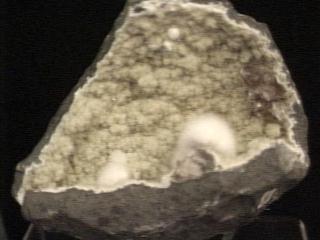
OKENITE specimen oke-1
$ 75.00
$ 75.00
Dims: 5-1/2" x 5" x 3"
Wt: 2 lbs., 7 oz
Poona, India
One of our finest Okenite specimens, this item is part of a basalt vug that was hacked out. It contains three "puffball" clusters of superfine Okenite needles, with no damage. These little white puffs each contain hundreds to thousands of crystals, each several times thinner than a human hair. Scattered around the Okenite puffs are several small white orbs of Gyrolite, and nearby is a cluster of pseudocubic Calcite with curiously curved edges and brown inclusions that I can't identify. All of these rest atop a bed of very fine Quartz crystals. This is a breathtaking piece that is just waiting for someone who can appreciate its beauty.

oke-1 ($ 75.00)
Poona, India
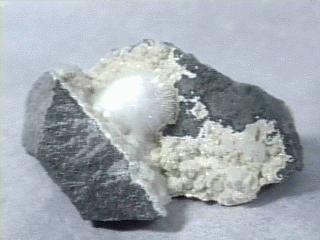
OKENITE specimen oke-2
$ 25.00
$ 25.00
Dims: 3-3/8" x 2-1/2" x 1-1/4"
Wt: 5.66 oz
Poona, India
A relatively small specimen for the collector with little space, this pristine specimen is made up of a hunk of basalt with a V-shaped cleft running across one side. One side of the "V" is coated with tiny quartz crystals, while the other is coated with dozens of tiny gyrolite globules. In the cleft, partially protected from the outside world, is one fuzzy white cluster of Okenite needles. The cluster measures about 1" in diameter, and has no damage. There is also a small patch of what seems to be laumontite. The price is right for this piece.
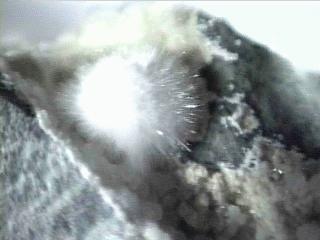

oke-2 ($ 25.00)
Poona, India
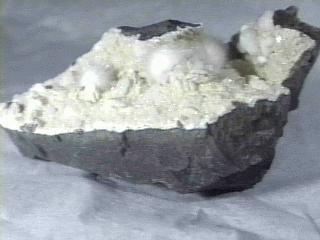
OKENITE specimen oke-3
$ 45.00
$ 45.00
Dims: 5" x 3" x 2-3/8"
Wt: 1 lb., 0.2 oz
Poona, India
This excellent specimen exhibits 3 Okenite clusters that rest on a bed of tiny quartz crystals that coat a largish hunk of basalt. The largest of these clusters measures about 1" in diameter; the other two are considerably smaller. There are also several botryoidal globules of gyrolite, and even a small amount of heavily fractured, grungy brown calcite. Again, the "puffballs" are undamaged, and the largest is rather well protected in a hollow.
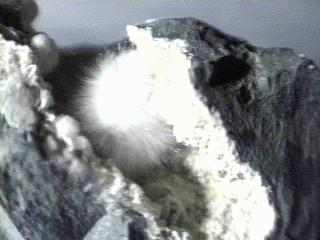

oke-3 ($ 45.00)
Poona, India
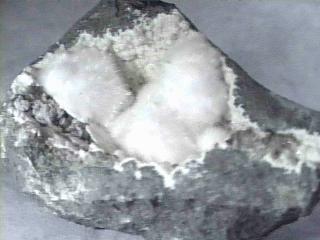
OKENITE specimen oke-4
$ 85.00
$ 85.00
Dims: 5-1/2" x 3-3/4" x 2-1/2"
Wt: 1 lb., 9.9 oz
Poona, India
One of our larger specimens, this piece contains more Okenite that I think I've ever seen in a specimen of its size. There are 5 discernable clusters, 4 of which have melded together. The largest of these has a diameter of almost 2", and the smallest, a diameter of 1/2 inch. All are in a deep, quartz-lined crevice in the basalt matrix; two are on the edge of the crevice, and are thus not protected as well as the others. There is slight damage to one of them. Other minerals include a few gyrolite globules, a crystal of laumontite peeking out from behind one of the clusters, and some white sheets of what may be laumontite, but I'm not sure-- whatever they may be, they are definitely delicate, and a pretty addition to a high-quality specimen.
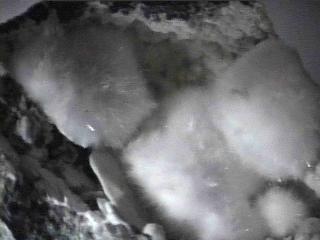

oke-4 ($ 85.00)
Poona, India
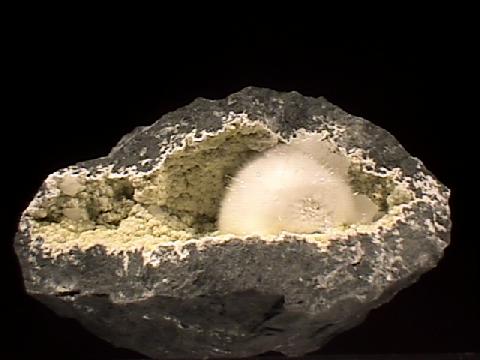
OKENITE specimen oke-5
$ 210.00
$ 210.00
Dims: 5.5 x 3.8 x 3.6" (14.0 x 9.7 x 9.1 cm)
Wt: 2 lbs., 7.4 oz. (1.116 kg)
Poona, Maharashtra State, India
This large hand specimen consists of a vug that was chiseled out of the basalt base rock in which it formed. This vug houses a large, rounded cluster of hundreds or thousands of radiating Okenite needles. Apart from a small but noticeable area of crushed crystals, the cluster is in very good condition. Given its 1.7" (4.3 cm) diameter, the crystals should have an average length of 0.8 or 0.9" (2.0 - 2.3 cm), but I have a feeling that they do not radiate from a central point. The Okenite needles are about as thin as human hairs, on the average, and so cannot be individually studied witout powerful magnification. They do reflect a bright pearly luster, however, and likely have good form. Though the crystals are likely colorless and transparent as individuals, the cluster has a white coloration and is likely only translucent at its edges. It rests among at least 2 rounded, incomplete gyrolite nodules that have a watery, milky white coloration and a waxy luster. There are a few others resting elsewhere in the hollow, but these are much smaller than those ajacent to the Okenite cluster.
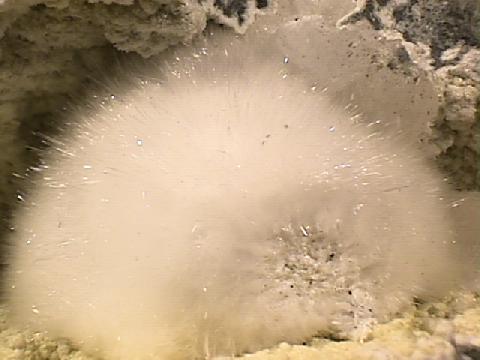

oke-5 ($210.00)
Poona, Maharashtra State, India
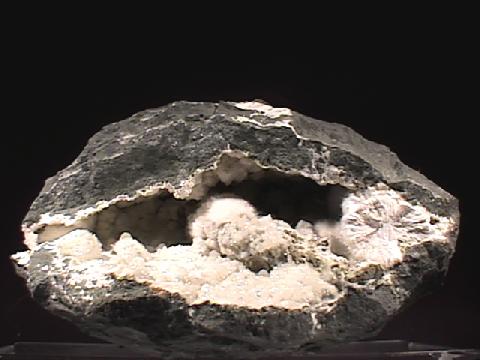
OKENITE specimen oke-7
$ 215.00
$ 215.00
Dims: 8.5 x 6.1 x 4.9" (21.6 x 15.5 x 12.4 cm)
Wt: 8.1 lbs. (3.7 kg)
Poona, Maharashtra State, India
This cabinet-sized specimen consists of a vug that was cut out of the surrounding basalt host rock. This vug contains, among other minerals, 6 complete and 1 incompete clusters of super-fine, radiating Okenite needles. The intact clusters appear to be in excellent condition and show no visible damage. Though the largest one has a diameter of about 1.3" (3.3 cm), the needles themselves are likely no longer than 0.3" (8 mm), covering a more massive core. As they are at least as thin as human hair, I cannot study their form, though it is most likely very good. The clusters all have a white coloration and are dimly translucent around their edges, though individual crystals are most likely colorless, transparent, and clear. Accompanying the Okenite in the vug are several stubby laumontite crystals, some very small prehnite orbs, a few larger gyrolite orbs, and possibly even a small amount of heulandite. Almost all of these minerals rest on a druse of tiny, transparent quartz crystals that coats the interior of the vug.
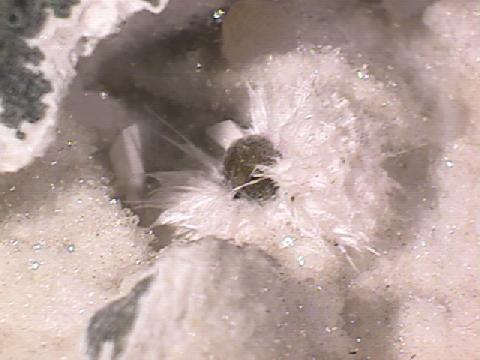

oke-7 ($215.00)
Poona, Maharashtra State, India
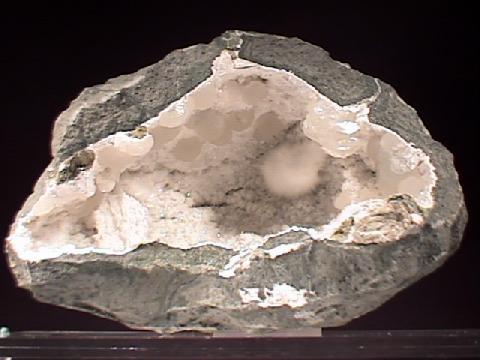
OKENITE specimen oke-8
$ 240.00
$ 240.00
Dims: 6.0 x 4.2 x 3.5" (15.2 x 10.7 x 8.9 cm)
Wt: 3 lbs., 11.0 oz. (1.672 kg)
Poona, Maharashtra State, India
Two separate and distinct Okenite clusters rest in the hollow of this specimen. Neither show signs of human-induced damage, though one is very heavily malformed- it looks as if it could have been crushed, but it is too well-protected inside the cavity. The other crystal looks like that which one would expect, and consists of thousands of superfine needles that are too thin to study without high magnification. The needles likely have good triclinic form, though, as one can see light reflected off of their faces in the form of a pearly luster. Individually, they would likely be colorless, transparent, and quite clear, but the cluster has a white color and is likely no more than translucent. The needles probably do not exceed 0.4" (1 cm) in length, and the cluster's general dimensions are approximately 1 x 0.5 x 0.5" (2.5 x 1.3 x 1.3 cm). They are not alone- a few well-formed but heavily intergrown calcites are clustered nearby, and at least 10 rounded prehnite nodules are scattered about the inner surface of the vug, which is coated with a thin, white druse of tiny quartz crystals.
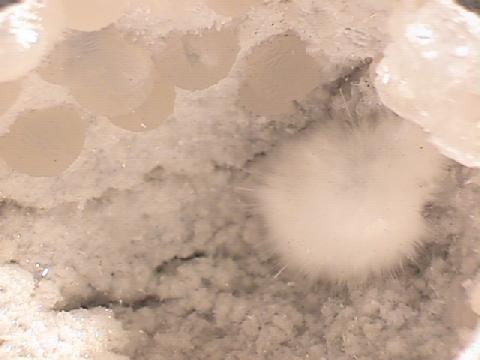

oke-8 ($240.00)
Poona, Maharashtra State, India
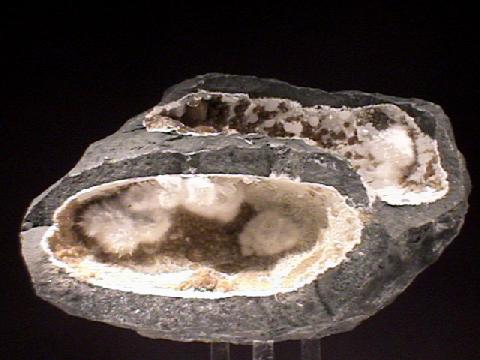
OKENITE specimen oke-9
$ 300.00
$ 300.00
Dims: 7.0 x 4.6 x 2.9" (17.8 x 11.7 x 7.4 cm)
Wt: 3 lbs., 6.9 oz. (1.560 oz.)
Poona, Maharashtra State, India
I call this specimen a "two-for-one special", as it consists of two vugs that are separated by a relatively thin layer of basalt. One of these has a slightly flattened ovoid (egg) shape, whereas the other has conformed part of its surface to the form of the first one. Both contain clusters of fine radiating, Okenite needles, however; the ovoid cavity contains at least 12, most of which are partly intergrown, whereas the other cavity contains 5 much smaller, intergrown clusters. Their diameter generally ranges from 0.2" (5 mm) to 0.7" (1.8 cm), and only the 2 most exposed clusters show any damage, in the form of a small number of broken or crushed crystals. These needles are far too thin to study without high magnification, but likely have excellent triclinic form, as one can see their pearly luster in light reflected off of their prism faces. They are all likely colorless, transparent, and clear, but the clusters have a milky-white coloration in general, and are probably merely translucent. Close examination will reveal several crystals of what appears to be laumontite peeking out from under some of the clusters. I think that all of the Okenite clusters are merely druses that cover such crystals. Score of brown gyrolite nodules are scattered in both depressions, and in some cases are intergrown to form reniform crusts that partly coat the cavity surfaces. They are accompanied by several small gyrolite nodules, and with all of the aforementioned, rest on a thin druse of tiny, white quartz crystals that line the inside of both cavities.
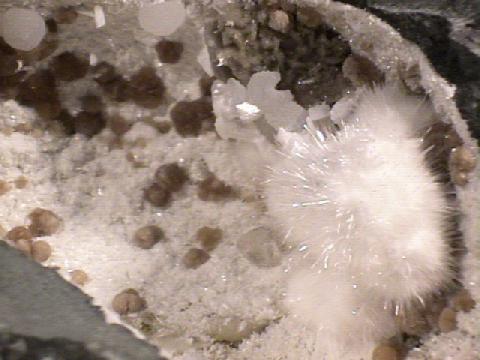

oke-9 ($300.00)
Poona, Maharashtra State, India
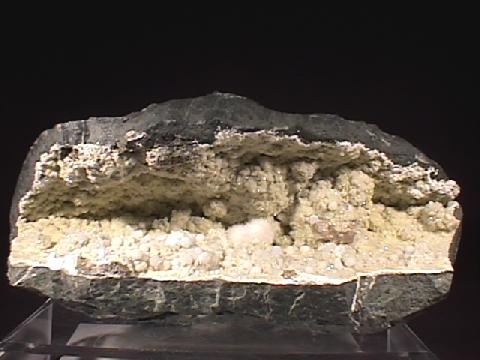
OKENITE specimen oke-10
$ 325.00
$ 325.00
Dims: 10.6 x 5.5 x 5.5" (26.9 x 14.0 x 14.0 cm)
Wt: 12.1 lbs. (5.5 kg)
Poona, Maharashtra State, India
There is less Okenite than any other mineral present on this cabinet-sized specimen, but the clusters are the most noticeable. I can count 8 sprays of radiating Okenite needles, 2 or 3 of which are either incomplete or possibly damaged. They range from 0.3" (8 mm) to 0.7" (1.8 cm) in diameter and have the classic milky-white coloration and fuzzy appearance. The crystals are incredibly fine, so one must use powerful magnification to study individual crystals. They are likely colorless and transparent by themselves, but clustering gives them their generally white color. The are accompanied by scores of round prehnite nodules, many gyrolite nodules, about 5 rounded pseudocubic calcites, a few basal-terminated tetragonal apophyllites, and two or three tiny laumontite crystals, all but one of which are damaged and incomplete. They rest on a thin quartz druse that coats the surface of the basalt vug in which all of the minerals rest.
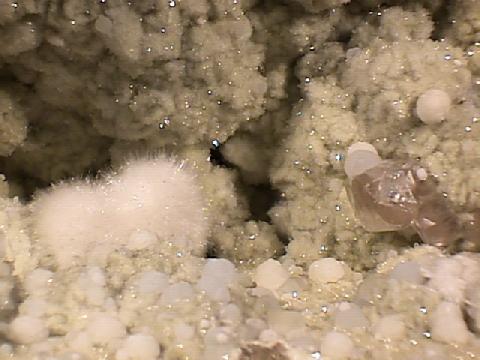

oke-10 ($325.00)
Poona, Maharashtra State, India
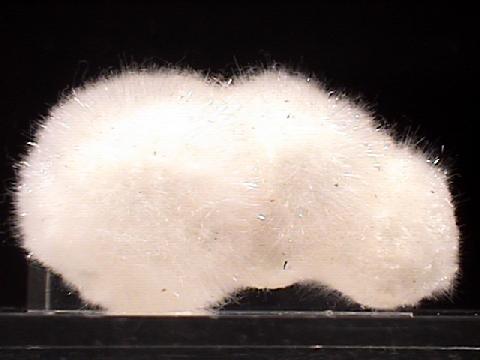
OKENITE specimen oke-11
$ 25.00
$ 25.00
Dims: 2.0 x 1.2 x 0.8" (5.1 x 3.0 x 2.0 cm)
Wt: 18.1 g
Bombay, India
This thumbnail specimen consists of three partly intergrown Okenite clusters. The clusters range in diameter from 0.8 - 1.2" (2.0 - 3.0 cm) and are in good condition, showing only a small amount of damage. Each is made up of countless needle-like crystals that are as thin or thinner than a human hair. Thus, their triclinic form is impossible to study with the naked eye, though each shows a pearly luster. Individually, crystals may be colorless and transparent, but the clusters are white in color and basically opaque. There is no host rock present, so great care must be used in handling the specimen.

oke-11 ($ 25.00)
Bombay, India
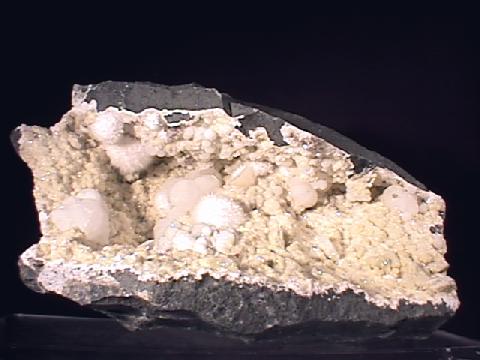
OKENITE specimen oke-12
$ 125.00
$ 125.00
Dims: 8.7 x 6.0 x 4.2" (22.1 x 15.2 x 10.7 cm)
Wt: 5.7 lbs. (2.6 kg)
Bombay, India
At least 6 separate and distinct Okenite clusters rest in this cabinet specimen. One small cluster is damaged, but the rest appear to be in excellent condition. They range in diameter from 0.3" (8 mm) to almost 1.0" (2.5 cm) and are made up of countless radiating Okenite needles, each of which is thinner than a human hair. Though I cannot effectively study it, their triclinic form is likely very good. Individual crystals are likely transparent and at least moderately clear, but the clusters generally have a white color and are translucent at least around their edges. They are accompanied by several large round prehnite nodules, at least one gyrolite nodule and several tiny calcites that have a nearly pseudocubic form. These rest in a hollow in the basalt host rock that is coated with a druse made up of hundreds or even thousands of tiny, transparent quartz crystals.
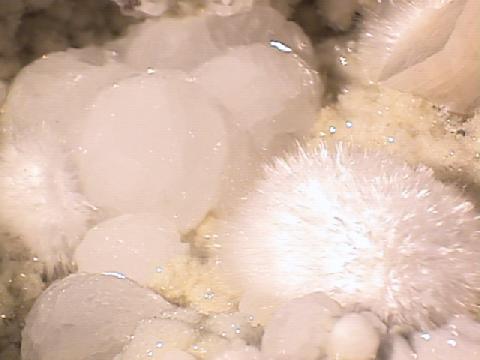

oke-12 ($125.00)
Bombay, India

OKENITE specimen oke-13
$ 60.00
$ 60.00
Dims: 6.3 x 3.0 x 3.0" (16.0 x 7.6 x 7.6 cm)
Wt: 2 lbs., 11.9 oz. (1.244 kg)
Bombay, India
Two partly intergrown Okenite clusters rest in a hollow in the basalt host of this hand specimen. These clusters are nearly identical in size, reaching diameters of about 1" (2.5 cm), and though one appears to be damaged, the crystals that form it are generally in very good condition. These crystals do not exceed 0.5" (1.3 cm) in length and are finer than human hair, so it is impossible to study their crystal form, even using a loupe. Individual crystals are colorless, transparent, and quite clear, but in a cluster they have an essential white color and are translucent. One small, brown calcite "cube" accompanies them, and the vug in which they rest is lined with a druse of hundreds or even thousands of tiny, transparent quartz crystals that are very well-formed.
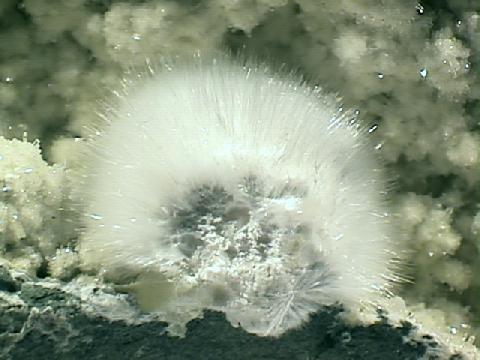

oke-13 ($ 60.00)
Bombay, India
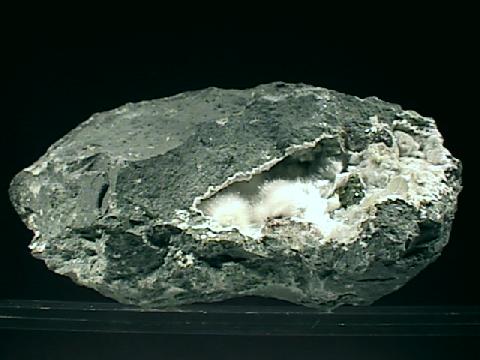
OKENITE specimen oke-14
$ 105.00
$ 105.00
Dims: 6.0 x 3.5 x 2.6" (15.2 x 8.9 x 6.6 cm)
Wt: 2 lbs., 7.9 oz. (1.132 kg)
Bombay, India
This specimen consists of a small vug that has been freed from its basalt surroundings. It is open at each end, so light can pass completely through it. At least 8 rounded clusters of Okenite needles rest in the space inside the vug. These clusters range in diameter from less than 0.5" (1.3 cm) up to over 1" (2.5 cm) and are generally in good condition, though one or two are visibly damaged. Each contains scores of fine Okenite needles each of which is thinner than a human hair. Their fineness makes it difficult to study their form, but each is colorless, transparent, and has a pearly luster. When clustered, however, they take on a dim translucence and are white in color. They are accompanied by several small gryolite nodules and a few stray calcites, and the hollow in which they rest is lined with a druse of very fine, white quartz crystals.


oke-14 ($105.00)
Bombay, India
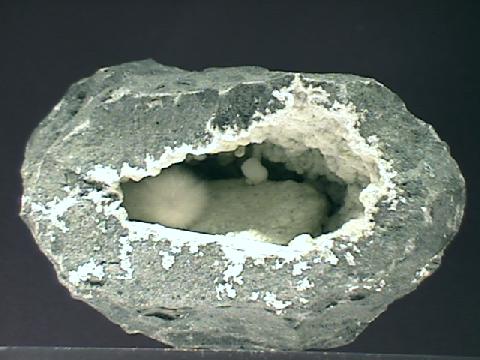
OKENITE specimen oke-15
$ 64.00
$ 64.00
Dims: 4.1 x 3.6 x 2.5" (10.4 x 9.1 x 6.4 cm)
Wt: 1 lb., 5.9 oz. (621 g)
Bombay, India
A very small basalt vug comprises this hand specimen. Within its hollow rest 1 partial and 3 complete Okenite clusters. Two of the complete clusters are undamaged and in excellent condition, and the other shows moderate damage in the form of crushed crystals. Each of these clusters is made up of countless tiny, radiating needles, each of which is thinner than a human hair. None of these are likely to exceed 0.4" (1.0 cm) in length, and all are too thin to effectively study even under 10-power magnification. However, their triclinic form is likely good. Individual crystals are colorless, transparent, and probably reasonably clear, but the clusters are essentially white in color and translucent at best. They are accompanied by a few intergrown gyrolite orbs and what appears to be a single, small laumontite crystal. The vug in which they rest is encrusted with a noticeable amount of calcite and a druse of microscopic quartz crystals.

oke-15 ($ 64.00)
Bombay, India
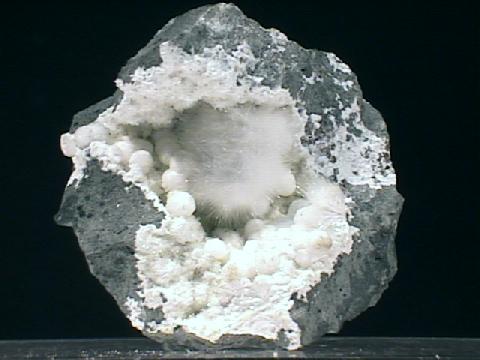
OKENITE specimen oke-16
$ 38.00
$ 38.00
Dims: 2.4 x 2.3 x 2.0" (6.1 x 5.8 x 5.1 cm)
Wt: 6.27 oz. (177.7 g)
Poona, Maharashtra State, India
A hollow in the basalt base rock of this piece holds 2 Okenite clusters. The smaller cluster is damaged and incomplete, but the larger cluster is intact and measures nearly 0.9" (2.3 cm) in diameter. It is made up of hundreds of superfine needles that likely do not exceed 0.4" (1 cm) in length. These needles are too thin to study without high magnification, but likely have good triclinic form. Though the cluster is white in color and appears to be opaque, individual crystals are colorless and transparent, possessing a pearly luster. They are accompanied by several small, round gyrolite nodules that also rest in the hollow. The hollow itself is lined with white agate that is coated with a druse of tiny, transparent quartz crystals.

oke-16 ($ 38.00)
Poona, Maharashtra State, India
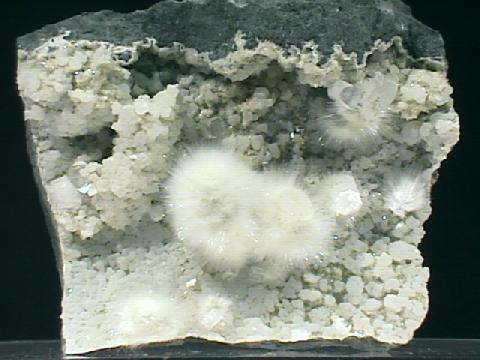
OKENITE specimen oke-17
$ 36.00
$ 36.00
Dims: 3.0 x 2.7 x 2.0" (7.6 x 6.9 x 5.1 cm)
Wt: 9.71 oz. (275.4 g)
Poona, Maharashtra State, India
The basalt base of this hand specimen holds 6 Okenite clusters. These clusters range in diameter from 0.3 -1.0" (0.8 - 2.5 cm) and though one is broken and another is noticeably damaged, the rest are intact and in excellent condition. Each cluster is made up of hundreds of superfine Okenite needles that likely do not exceed 0.4" (1.0 cm) in length. Each needle is far thinner than a human hair and likely has good triclinic form. As individuals, they are colorless, transparent and have a pearly luster, but the clusters are white in color and essentially opaque. They are accompanied by one or two gyrolite nodules, a few tiny laumontite prisms, several apophyllites, and socres of small, round prehnite nodules. All of these rest on a thin, white agate crust that partly coats the basalt.

oke-17 ($ 36.00)
Poona, Maharashtra State, India
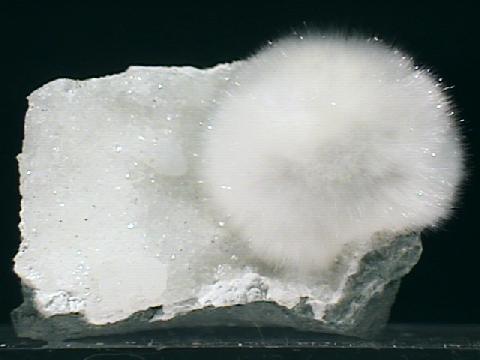
OKENITE specimen oke-18
$ 35.00
$ 35.00
Dims: 2.0 x 1.9 x 1.4" (5.1 x 4.8 x 3.6 cm)
Wt: 2.15 oz. (61.0 g)
Poona, Maharashtra State, India
A single Okenite cluster rests on the basalt base of this specimen. This cluster has an approximate diameter of 1.1" (2.8 cm) and is in excellent condition, showing only a few small spots of damage. The cluster is made up of hundreds of radiating needle-like crystals that do not exceed 0.6" (1.5 cm) in diamter and are thinner than human hair. Though they are too thin for me to effectively study as individuals, they likely have good triclinic form. Each is colorless, transparent, and has a pearly luster, though the cluster itself is essentially white and opaque. Several small gyrolite nodules rest nearby, and all are separated from the base rock by a druse of tiny quartz crystals and a thin layer of white agate- one can see some botryoidal form on one edge of this agate crust.

oke-18 ($ 35.00)
Poona, Maharashtra State, India
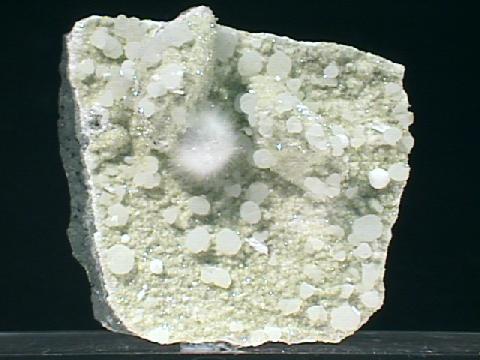
OKENITE specimen oke-19
$ 28.00
$ 28.00
Dims: 2.5 x 2.2 x 1.5" (6.4 x 5.6 x 3.8 cm)
Wt: 5.08 oz. (144.1 g)
Poona, Maharashtra State, India
A single, round Okenite cluster rests on the basalt base of this piece. This cluster measures about 0.5" (1.3 cm) in diameter and is in excellent condition, showing only a very small amount of crushing damage to some of the more exposed crystals in one area. These crystals do not generally exceed 0.3" (8 mm) and each is much thinner than a human hair, making it impossible for me to study their triclinic form. It is likely good, however, as one can see a pearly luster on each needle. Individual crystals are colorless and transparent, but the cluster as a whole is white and translucent at best. It is accopmanied by several prehnite globules, a few stubby laumontites, and 3 or 4 gyrolite nodules. A thin layer of crystalline quartz and white agate separates the cluster from the basalt base.

oke-19 ($ 28.00)
Poona, Maharashtra State, India
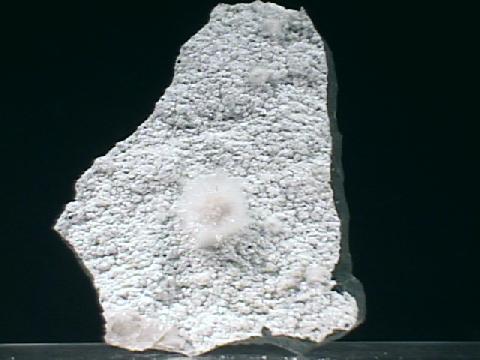
OKENITE specimen oke-20
$ 28.00
$ 28.00
Dims: 4.0 x 3.4 x 1.5" (10.2 x 8.6 x 3.8 cm)
Wt: 9.09 oz. (258.0 g)
Poona, Maharashtra State, India
The basalt base of this specimen holds 6 visible Okenite clusters. Three of these clusters appear to be either incomplete or damaged, and all but one measure less than 0.2" (5 mm) in diamter. The large cluster is intact and in excellent condition and measures 0.9" (2.3 cm) in diamter. It is made up of hundreds of radiating needle-like crystals that do not exceed 0.5" (1.3 cm) in length. These needles are far too thin for me to effectively study, but likely have good triclinic form. As individuals, they are colorless, transparent and have a pearly luster, but the clusters have a white color and are essentially opaque. A small, incomplete calcite cluster rests on the edge of the base rock, and the surface surrounding the big cluster is encrusted with white agate and littered with small laumontite crystals and countless more, nearly microscopic Okenites.
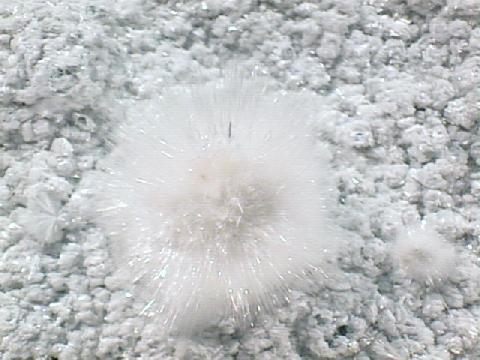

oke-20 ($ 28.00)
Poona, Maharashtra State, India
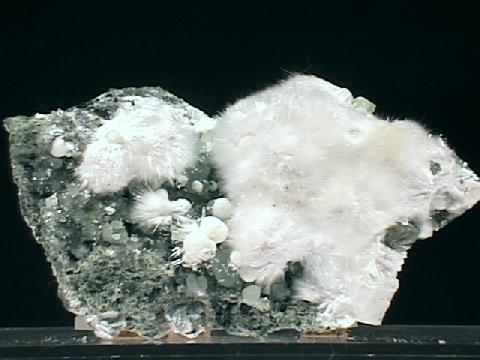
OKENITE specimen oke-21
$ 25.00
$ 25.00
Dims: 3.3 x 2.0 x 1.6" (8.4 x 5.1 x 4.1 cm)
Wt: 3.70 oz. (105.1 g)
Poona, Maharashtra State, India
This hand specimen consists of a basalt base on which rest several Okenite clusters, most of which are intergrown. These clusters are in fair condition, showing considerable damage, and contain hundreds or perhaps thousands of Okenite needles. These needles reach lengths of nearly 0.5" (1.3 cm) and are too thin to study without high magnification. Their triclinic form is likely good, however, and each is colorless, transparent, and has the standard pearly luster. The clusters, on the other hand, have a generally white coloration and are essentially opaque. Each cluster appears to have grown off of a crystalline laumontite base, and is accompanied by several gyrolites, scores of small prehnites (upon which they rest), a few druses of tiny quartz crystals, and even a broken calcite or two.

oke-21 ($ 25.00)
Poona, Maharashtra State, India
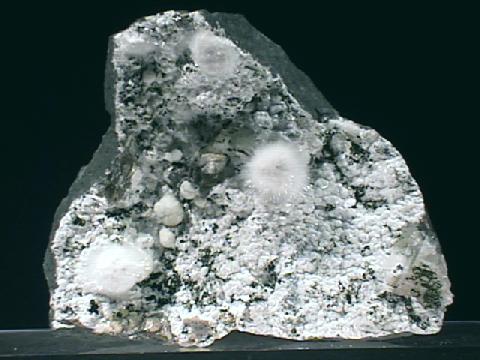
OKENITE specimen oke-22
$ 40.00
$ 40.00
Dims: 5.0 x 4.3 x 2.0" (12.7 x 10.9 x 5.1 cm)
Wt: 1 lb., 3.4 oz. (551 g)
Poona, Maharashtra State, India
Four Okenite clusters rest on the basalt base of this cabinet specimen. The two smallest clusters are visibly damaged and one is incomplete, but the larger ones are intact and in excellent condition, measuring approximately 0.8" (2 cm) in diameter. Each cluster is made up of hundreds of Okenite needles that do not exceed 0.4" (1 cm) in length and are much thinner than human hair. Their triclinic form is probably good, and all show a pearly luster. Though the clusters are white in color and essentially opaque, individual crystals are colorless and transparent. Several gyrolite nodules rest nearby, along with a few broken, brown calcite clusters. All are separated from the basalt base by a thin, white agate crust that appears to be covered with tiny, intergrown laumontite crystals.


oke-22 ($ 40.00)
Poona, Maharashtra State, India
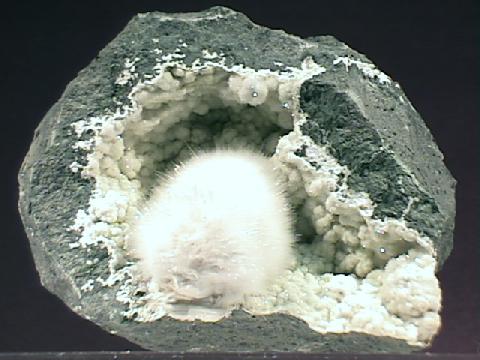
OKENITE specimen oke-23
$ 40.00
$ 40.00
Dims: 3.5 x 2.7 x 2.3" (8.9 x 6.9 x 5.8 cm)
Wt: 14.9 oz. (423 g)
Poona, Maharashtra State, India
Two intergrown Okenite clusters rest in a hollow on this hand specimen. These clusters are so intergrown that they have essentially become one, and together they have dimensions of about 1.2 x 1.1 x 0.8" (3.0 x 2.8 x 2.0 cm). The cluster is made up of countless Okenite crystals that are generally in good condition, though the most exposed part of the cluster is obviously damaged. The crystals likely do not exceed 0.3" (8 mm) in length and are so fine that a microscope is needed to study their triclinic form. Individually, they are colorless and transparent and have a pearly luster, but the clusters are generally white in color and dimly translucent at best. They likely grow off of small laumontite crystals, and rest atop a very thin druse of tiny quartz crystals or apophyllites. This druse in turn coats a very thin layer of white agate that lines the inside of the basalt vug.

oke-23 ($ 40.00)
Poona, Maharashtra State, India
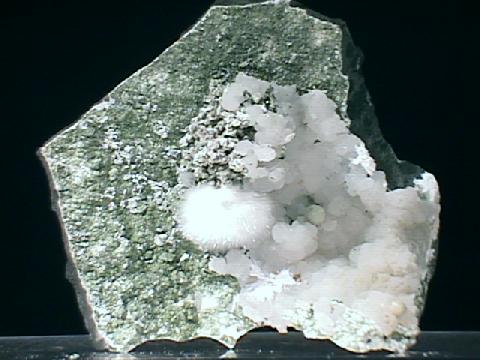
OKENITE specimen oke-24
$ 30.00
$ 30.00
Dims: 3.9 x 3.6 x 1.9" (9.9 x 9.1 x 4.8 cm)
Wt: 14.8 oz. (420 g)
Poona, Maharashtra State, India
A single complete Okenite cluster rests on the basalt base of this hand specimen. The cluster is in good condition and has a diameter of just under 1" (2.3 cm). It is made up of hundreds of superfine, radiating Okenite needles that generally do not exceed 0.4" (1 cm) and are each thinner than a human hair. Thus they are far too thin to effectively study except under high magnification. Even so, they probably have very good triclinic form. As individuals, they are colorles, transparent and have a pearly luster, but the cluster is generally white in color and translucent at best. The cluster rests next to a prehnite crust on which lay a few small gyrolites, and is adjacent to an odd formation of either calcite or possibly heulandite. A very thin layer of white agate lies between these minerals and the basalt base.
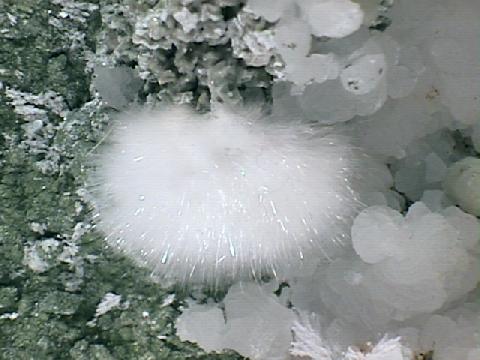

oke-24 ($ 30.00)
Poona, Maharashtra State, India
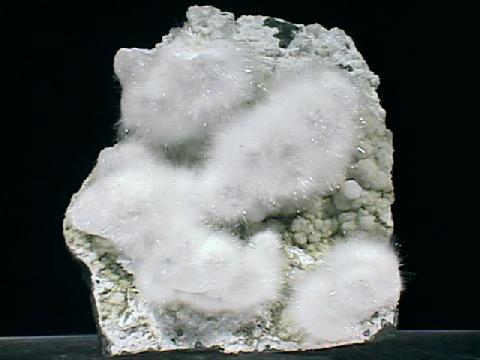
OKENITE specimen oke-25
$ 29.00
$ 29.00
Dims: 3.0 x 3.0 x 2.0" (7.7 x 7.5 x 5.0 cm)
Wt: 6.59 oz. (186.9 g)
Poona, Maharashtra State, India
Several intergrown Okenite clusters rest on the basalt base of this hand specimen. These clusters do not exceed 0.8" (2 cm) in diameter and are generally in good condition, though 3 of them are obviously damaged. Each is made up of countless superfine Okenite needles that likely do not exceed 0.3" (8 mm) in length. They are far too fine to study without magnification, but their triclinic form is likely good. The clusters are white in color and translucent around their edges, though individual crystals are colorless, transparent, and probably clear. A cluster of prehnite nodules and a single gyrolite orb rest on the basalt base, which is covered by a thin layer of agate.

oke-25 ($ 29.00)
Poona, Maharashtra State, India
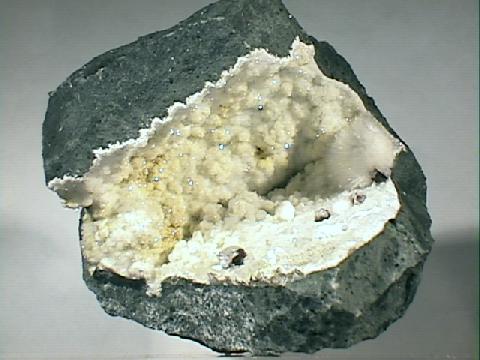
OKENITE specimen oke-26
$ 120.00
$ 120.00
Dims: 4.2 x 3.1 x 3.5" (10.7 x 7.9 x 8.9 cm)
Wt: 1 lb., 15.3 oz. (886 g)
Poona, Maharashtra State, India
Two small Okenite clusters rest in the hollow of the basalt base of this cabinet specimen. These clusters are in good condition- the larger one is slightly exposed and some crystals are crushed- an have diameters of 0.7" (1.8 cm) and 0.3" (0.8 cm). Each is made up of scores of very fine Okenite needles that are a bit too thin to effectively study with a loupe, but likely have very good triclinic form. Though each needle is colorless, transparent and clear, the clusters are effectively white in color and opaque. They are accompanied by several small laumontites, a few calcites with excellent form, and a single gyrolite nodule. The hollow in which they rest is lined with microscopic quartz crystals and white agate.

oke-26 ($120.00)
Poona, Maharashtra State, India

OKENITE specimen oke-27
$ 30.00
$ 30.00
Dims: 4.2 x 3.2 x 0.4" (10.7 x 8.0 x 1.1 cm)
Wt: 2.1 oz. (60 g)
Poona, Maharashtra State, India
Two weathered Okenite clusters rest on the prehnite base of this flat cabinet specimen. The larger of the clusters measures just over 0.5" (1.3 cm) in diameter and like the smaller one, is in fair condition due to the weathering- most of the crystals have been broken or bent into clumps, so that it is impossible to isolate a single needle. The clusters still have their white color, but the standard pearly luster is no longer there. The clusters are accompanied by several gyrolite nodules, and the prehnite base occurs in the form of a very thin crust with light botryoidal forms.

oke-27 ($ 30.00)
Poona, Maharashtra State, India
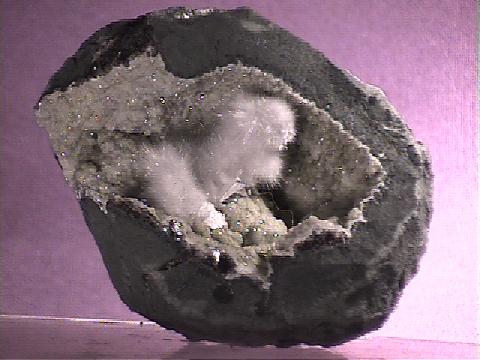
OKENITE specimen oke-29
$ 40.00
$ 40.00
Dims: 3.5 x 2.8 x 2.3" (8.8 x 7.1 x 5.9 cm)
Wt: 12.2 oz. (346 g)
Poona, Maharashtra State, India
This small cabinet-sized specimen consists of a basalt vug in which rest a few heavily-intergrown Okenite sprays. The sprays are in excellent condition and do not exceed 0.6" (1.5 cm) in diameter. Each cluster is made up of countless Okenite needles that are far too thin to effectively study as individuals- however, their triclinic form is likely good, and each appears to have a pearly luster. These clusters grow off a base of intersecting laumontites, which in turn rest on a thin layer of drusy white agate which lines the vug. Patches of brown, intergrown calcites are trapped under this crust in a few places.
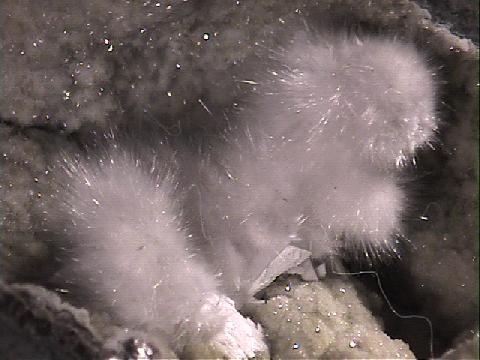

oke-29 ($ 40.00)
Poona, Maharashtra State, India

OKENITE specimen oke-28
$ 25.00
$ 25.00
Dims: 3.9 x 1.8 x 1.6" (10.0 x 4.7 x 4.2 cm)
Wt: 6.2 oz. (175 g)
Poona, Maharashtra State, India
Two clusters of radiating Okenite needles rest on the basalt base of this small cabinet specimen. The larger of the clusters measures nearly 1" (2.5 cm) along one axis, and is much larger than the other. Though they are too fine to study even with a loupe, their triclinic form is likely very good. Individual crystals are colorless, transparent and have a pearly luster, but the clusters are generally milky-white and dimly translucent. They are accompanied by a few round prehnite nodules and a cluster of intergrown heulandite. All rest on a thin, white chalcedony base that partly coats the basalt base.

oke-28 ($ 25.00)
Poona, Maharashtra State, India